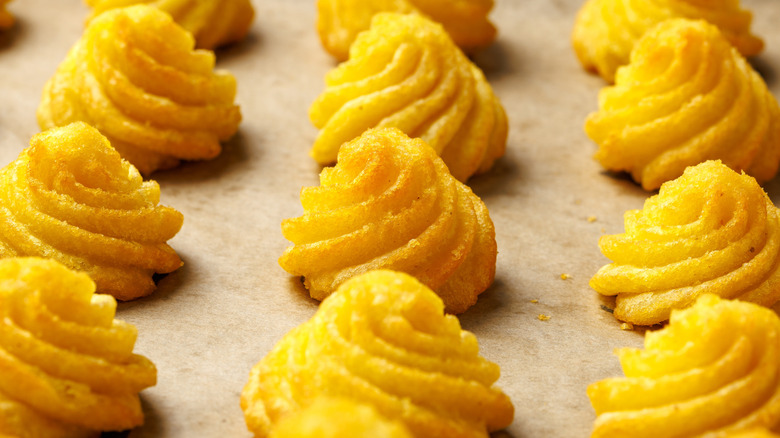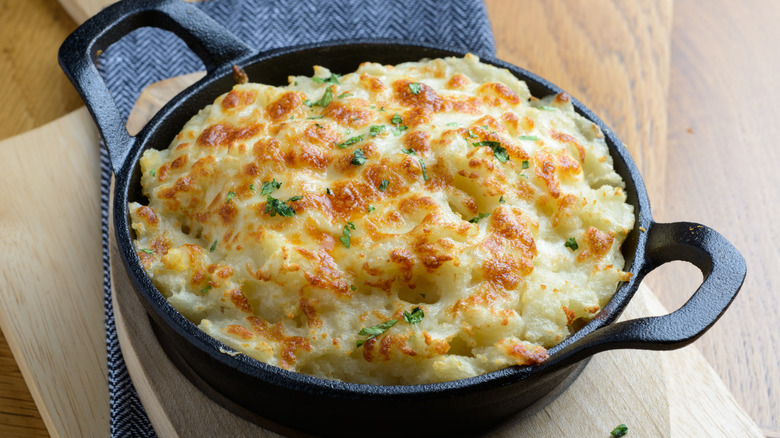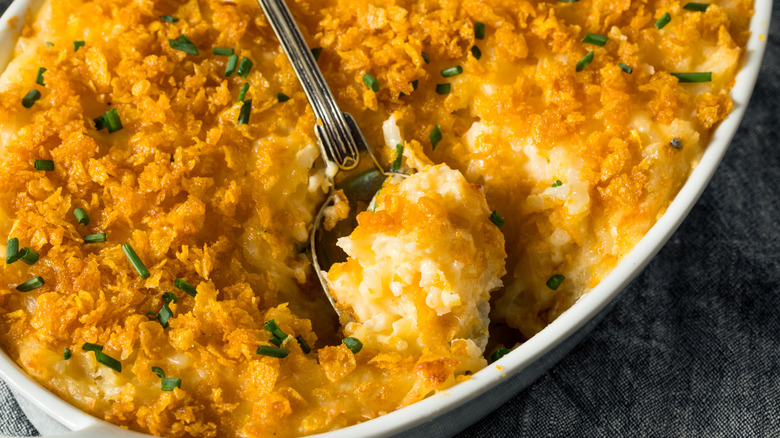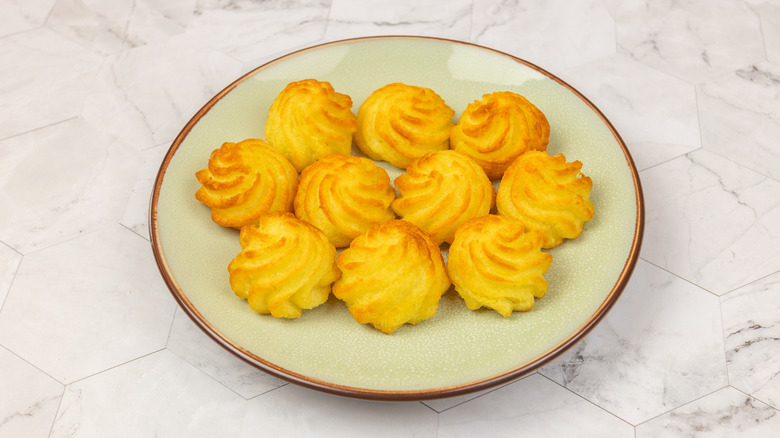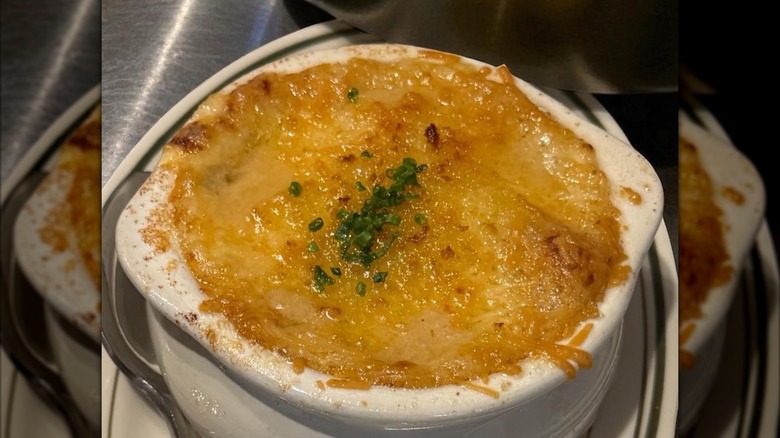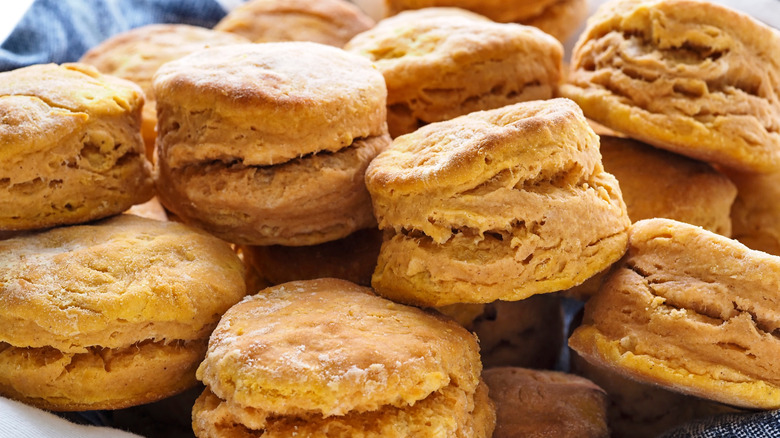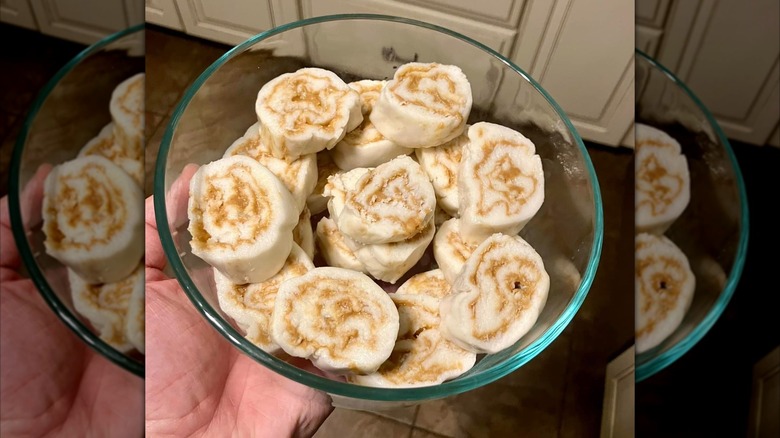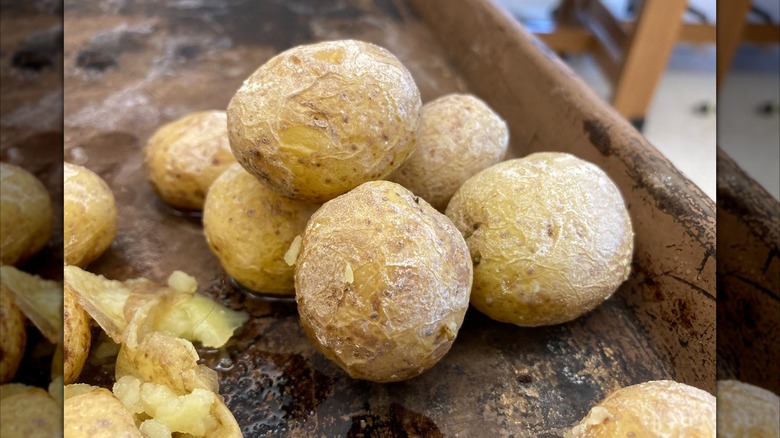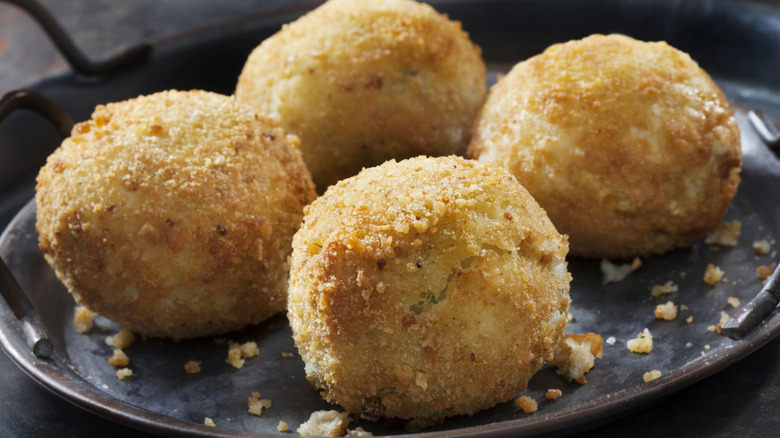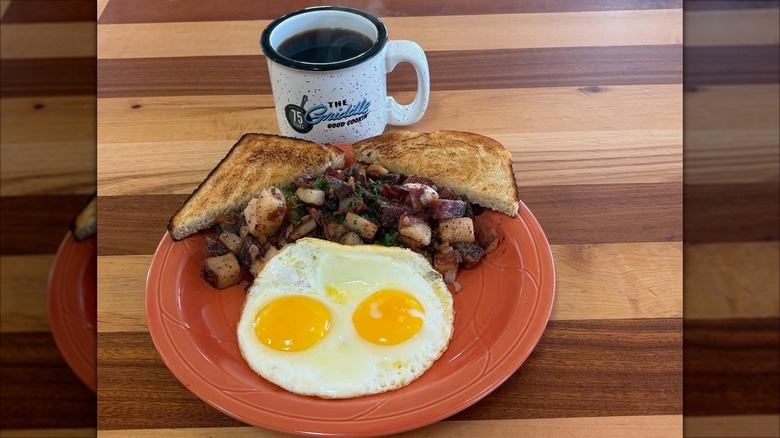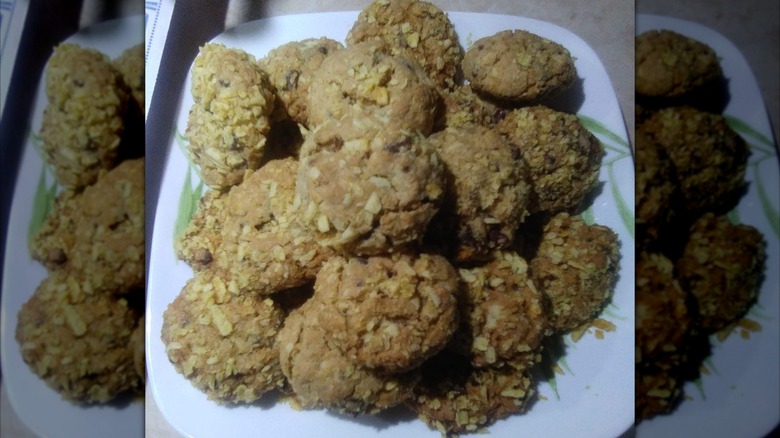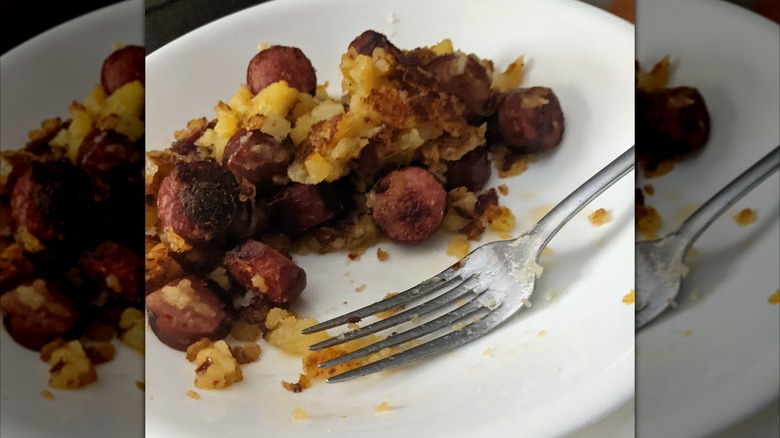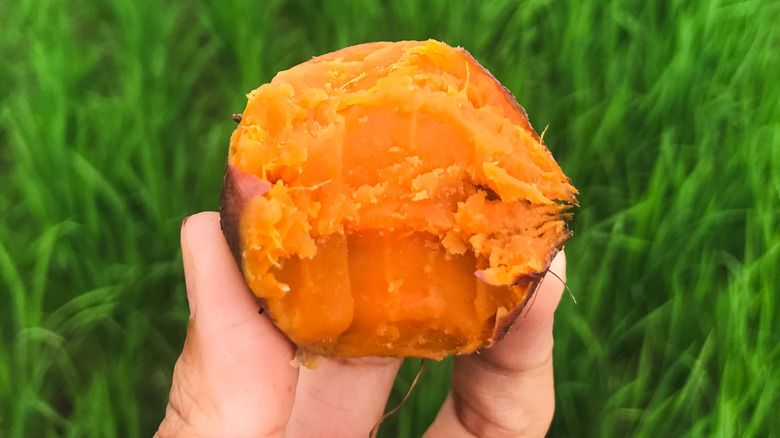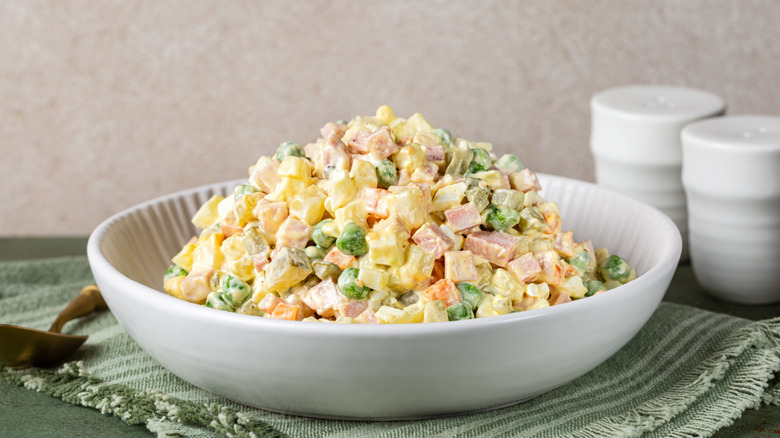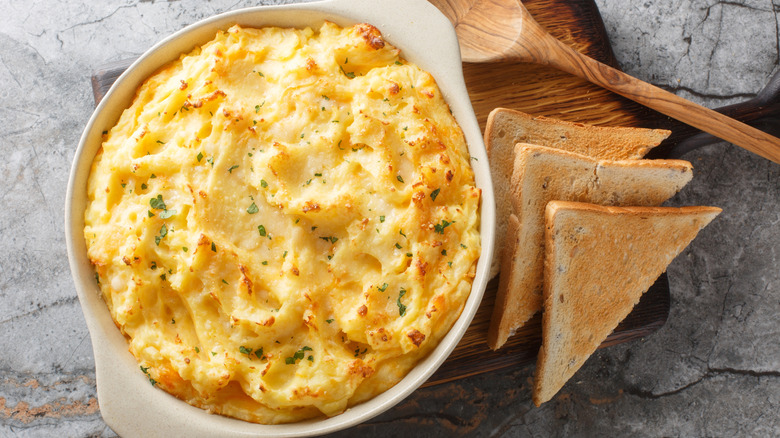14 Vintage Potato Dishes That Deserve A Comeback
Potatoes are seemingly everywhere in the American diet. At breakfast, you've got hash browns and home fries. Lunch or dinner? Fries, baked potatoes, potato soup, au gratin potatoes, potato salads, mashed potatoes — you could eat potatoes for every meal, for a not insignificant amount of time and still probably not run into the same way to eat potatoes twice. Meanwhile, while some have tried to malign the mighty potato, calling it a starchy, unhealthy food, potatoes actually are quite good for you in moderation, containing fiber, antioxidants, vitamin C, potassium, and more.
Potatoes haven't always been popular, though. First cultivated in the Andes, European invaders took the potato back home with them, where the vegetable was slow to catch on. Countries began recognizing the potato's nutritional value and reliability as a crop, but many still worried the plants were poisonous. At one point, a Prussian ruler had to threaten his people to eat more potatoes, or they'd have their nose and ears cut off (that threat worked out pretty well). Eventually, potatoes became a staple and they remain that way today.
Still, with all the many ways you can eat potatoes now, there are some potato dishes that probably won't make it into your spud-eating rotation, simply because you don't know about them. These are some of the historic and vintage potato dishes that have been mostly lost to time — but that seriously deserve a comeback.
World War I potato pie
The reliable, cheap, nutritious potato was a staple during the world wars, on both sides of the pond. Data from the United Kingdom's Ministry of Food showed that, between 1940 and 1949, the average working class person ate about 4 ½ pounds of potatoes per week. That's about eight or nine medium-sized potatoes.
It wasn't just the folks at home eating lots of potatoes, though. Those in the military ate their fair share of spuds as well, and we have that fact to thank for the World War I potato pie. A more economical version of a cottage or shepherd's pie, soldiers would make their World War I potato pie by stewing whatever meat was available with some onions; boiling and mashing potatoes; and then pressing the mashed potatoes into a baking dish, all on the bottom and sides, creating a well. The meat and onions filled the center, more potatoes were layered on top to cover it all, and then the dish was baked until the top browned. During baking, the potatoes soaked up the juices from the meat, making for a more savory, more moist mash during a time when butter and milk were lacking.
Funeral potatoes
Many foods claim ties to funerals. For their funerals, the Pennsylvania Dutch traditionally baked raisin pies (one of the old-school pie flavors almost everyone has forgotten about), which was a laborious process, as every grape had to be de-stemmed and de-seeded by hand; however, this hard labor was viewed as a sign of respect and care for the grieving family. Meanwhile, in the Victorian era, funeral cookies were distributed at wakes and burials, which were sometimes Lady Fingers wrapped in paper printed with appropriately morbid passages or imagery, such as cross bones or coffins.
However, while raisin pie is only going to appeal to you if you really love raisins, and funeral cookies with their goth wrappers may seem a little tacky today, funeral potatoes are a historic funeral food deserving of a broader comeback. Essentially a casserole at heart, funeral potatoes can be traced to Mormon communities. It's a mix of potatoes (you can throw hash browns, tater tots, and diced potatoes all together) paired with cheese and a creamy element, then topped with something crunchy, and all baked until golden brown. The dish is versatile and can be crafted with whatever you have on hand.
Duchess potatoes
Duchess potatoes are what you'd get if you gave your standard mashed potatoes a serious glow up. Created in France in the 1800s, the dish isn't named after any particular duchess. Instead, the name is a nod to just how fancy and elegant these little bites appear. By the early 1900s, duchess potatoes were being served by top French chefs in luxury settings, such as on the Orient Express.
For all their fanciness, though, duchess potatoes are pretty easy to make and require minimal ingredients. You basically make some mashed potatoes as normal, then allow them to cool before adding egg yolks. Then, you place the mixture in a piping bag and pipe the potatoes into little swirls, before baking them until golden brown. The eggs are a necessary part of the process, as they give your normal mashed potatoes more structure, while acting as a binding ingredient.
Delmonico potatoes
While Delmonico potatoes could historically be found in fanciful settings just like duchess potatoes, Delmonico potatoes don't quite feel as fancy. In fact, this dish feels like a comfort food classic, even if it hasn't retained the same popularity as, say, meatloaf or tuna casserole. Created at New York City's Delmonico's restaurant – where quite a few famous dishes came to be, including baked Alaska and eggs benedict — Delmonico potatoes go way back. In fact, some say that Abraham Lincoln himself loved this dish. The dish spread beyond Delmonico's walls and, as recently as the 1950s, you could find it served as a part of your in-flight meal on United Air Lines.
So what is it? Diced, cubed, or shredded potatoes are baked with half-and-half and pimentos until done, then topped with cheese before the dish goes back into the oven to melt that cheese. It's a completely easy, basic dish that could be served in place of your typical hash brown casserole at breakfast, or as a potato side dish at dinner.
Potato biscuits
Like World War I potato pie, potato biscuits were a wartime necessity. As countries prioritized using their wheat to make bread for their troops, they advised home cooks to use wheat alternatives, and one of those alternatives was potatoes. A 1917 recipe for potato biscuits simply mixed mashed potatoes with salt, butter, sugar, milk, flour, eggs, and yeast, to create more of a batter than a dough, which could be baked in a baking dish rather than on a flat baking sheet that you might use for biscuits today.
However, don't mix up potato biscuits with another historic, potato-based biscuit that's not as popular as it once was (at least not in most parts of the country). The sweet potato biscuit was enjoyed by the founding fathers during the Revolutionary Era, with some crediting Thomas Jefferson for their creation. Unlike World War I potato biscuits, sweet potato biscuits do include flour, but mashed sweet potatoes are added to the mix along with pecans, brown sugar, and a bevy of spices that'll make you think of a sweet potato casserole.
Potato candy
Potato candy is yet another example of a potato dish that came about simply because potatoes are cheap and readily available when many other ingredients are not. Particularly popular in Appalachia among German and Irish immigrant families, but waning in popularity in the modern day, potato candy gained a widespread fanbase during the Great Depression, due to its affordability and few ingredients: potatoes, peanut butter, and sugar.
To make potato candy, all you need to do is cook and mash a potato, and then mix it with confectioner's sugar (it sounds odd at first, but just trust the process) to form a kind of dough. You then spread the dough out on a piece of wax paper, forming a large rectangle. Imagine you're making a pumpkin roll, because the concept is nearly the same. Spread a layer of peanut butter onto the potato mixture, and then use the wax paper to roll it all into a log. When you cut the log into slices, you'll reveal a swirl of peanut butter.
Salt potatoes
Salt potatoes didn't gain 19th-century popularity due to potatoes' widespread availability, but instead, the plentiful amount of salt available in this dish's place of origin. In the late 1800s, central New York supplied a very large majority of the United States' salt supply. At the time, processing mined salt required boiling the salt and, eventually, workers decided to throw some potatoes into that boiling salt, to cook up an easy lunch. The dish grew beyond the salt-mining workforce and entered the mainstream.
While you can still find salt potatoes in the region, the dish hardly maintains the popularity it once did, even though making salt potatoes is just about as easy as it comes (and, no, you don't need to visit a salt mine to make it happen). A very large amount of salt is dissolved in water, and then potatoes are added before bringing the water to a boil. After the potatoes are done, as they cool, they'll develop a salt crust. Drizzle them with melted butter and you've got a miner's lunch.
Potato balls
Potato balls were the early American version of a croquette. Eighteenth-century recipes called for home cooks to combine mashed potatoes (made with potatoes that had been cooked with the skin on, specifically, so as to retain the potato's starch) with egg yolks, forming a pliable-yet-sturdy mixture that could be formed into balls. The balls were floured, dipped in more egg yolk and breadcrumbs, before frying.
Potato croquettes are very similar, but you're more likely to see them on a menu today versus the somewhat clumsily named potato balls. Originating in France, modern croquettes made with leftover mashed potatoes incorporate flour as a binding ingredient rather than an egg, but they're still dipped in eggs and breadcrumbs before cooking. Additionally, potato croquettes are often formed into short cylinders rather than balls.
However, potato balls did maintain some popularity beyond the Revolutionary era. In the 1940s, the British Ministry of Food issued a recipe for "surprise potato balls," encouraging Brits to eat more potatoes. These balls, though, added grated carrot to the mashed potato mixture, and the "surprise" was that the balls were filled with a chopped sweet pickle center. The balls were also served with gravy.
Red flannel hash
With roots planted in 1910s New England, red flannel hash ticks a lot of boxes as a dish representative of its time and place. It made use of the wartime-favorite potato. It incorporated convenient and cheap canned ingredients, as the canning industry began to grow. It leaned on inspiration from immigrant communities, primarily Irish-Americans. The dish is what you'd expect from a hash, with diced potatoes and corned beef, but adds in a special ingredient that gives it that "red flannel" flair: beets.
However, some say that an earlier version of this dish existed in the New England colonies. That version, though, left out the corned beef that was made readily available in the 1930s due to the advent of commercial canning. It still included the potatoes and the beets, though, and possibly could have thrown in some cabbage. Whatever the case, recipes for the dish were still being publicized in the 1970s, and those recipes didn't deviate far from the same recipes used in the 1910s.
Potato chip cookies
The closest most people get to a potato chip cookie is a kitchen sink or trash can cookie that attempts to throw everything possible into a sweet-savory treat that's more mix-ins than actual cookie dough. A cookie with just potato chips added for texture and intrigue is a little rarer. Mention potato chip cookies and you'll probably hear things like "My grandma made these when I was a kid." There's a good reason for that – in the 1970s, potato chip cookies were a recommended gift to send military personnel stationed in Southeast Asia, as they were expected to keep well (have you ever tried to ship a homemade chocolate cookie?).
The recipes for potato chip cookies differ, but the spirit is the same. Essentially, you make a basic sugar cookie, and then add crushed potato chips into the batter. Sometimes you roll each cookie into a ball before baking, rolling that ball in crushed potato chips. Sometimes you add nuts. Sometimes you use brown sugar, sometimes you don't. Some recipes specifically call for classic Lay's potato chips, while others specify that you should use Pringles. Whatever the recipe, though, the result is the same: a delicious sweet and savory cookie that carries a certain nostalgic factor.
The Poor Man's Meal
With a name like "The Poor Man's Meal," is it any wonder that this dish has fallen out of fashion? Still, if you think fondly of cheap eats from your childhood that incorporate some sliced hot dogs — think beanie weenies or hot dog mac and cheese — chances are good that you're going to like the Poor Man's Meal.
A Great Depression invention, the Poor Man's Meal was cheap, easy, and required minimal ingredients — just potatoes, onions, hot dogs, oil, salt, and pepper. Potatoes and onions are chopped, seasoned, and pan-fried in oil. Then, you cut up your hot dog and continue cooking until the hot dogs are done.
While hot dogs may feel a bit modern, they were pretty widely eaten by the 1930s, having been introduced to American consumers in the late 19th century. During the Depression, you could buy a hot dog for about a nickel or dime. In Chicago, the "Depression Dog" – topped with mustard, onions, pickled peppers, and piccalilli – was the predecessor to the Chicago-style dog.
Sweet potato apples
Two favorite pieces of fall produce, sweet potatoes and apples often find themselves paired together in various seasonal dishes. However, what if you actually take the sweet potato and form it into the shape of an apple? That was what a 1950 Betty Crocker cookbook instructed home cooks to do.
A fun twist on sweet potato casserole, the recipe calls for you to shape mashed baked sweet potato around a marshmallow, forming an apple-like shape. (You can add a clove to one end of your carefully sculpted apple, for the stem). Give it an egg wash and bake it, and you have an eye-catching, new addition to your Thanksgiving table, complete with a gooey surprise inside.
Want to level up this idea even further? Try rolling your sweet potato apple in cracker crumbs and then frying it, as one Reddit user reported their family does at every holiday.
Olivier salad
Olivier salad, sometimes also called Russian potato salad, hasn't become a summer side dish staple in the same way that American potato salad has, and for little good reason. Created by and named for Belgian-Russian chef Lucien Olivier, in the 1800s, Olivier salad can still be found throughout Russia and some post-Soviet countries.
The potato salad stands apart from typical American potato salad in a few key ways. This is not large chunks of potatoes, plus maybe some hard boiled eggs and pickles, all drowning in mayonnaise and mustard. Instead, Olivier salad brings more variety to the party, in the form of carrots, pickled beets, and depending on the recipe, peas, apples, ham, or sausage.
The salad was such a big deal when it was first served by Chef Olivier at the Hermitage restaurant that multiple attempts were made to steal the original recipe. No one was ever 100% capable of doing so, and so many copycat attempts were made to varying degrees success. One of the very first copycat recipes called for grouse, duck, veal, caviar, potatoes, pickles, crayfish, capers, lettuce, olives, aspic, and the 19th-century version of mayonnaise — a far cry from the modern variant that's largely accepted today.
Potato filling
Whether you call it stuffing or dressing, when Thanksgiving rolls around, you're likely cooking up a version of the stuff. Maybe you prefer it to be made with stale bread, cornbread, sausage, oysters, or mushrooms — but have you considered potatoes? A Pennsylvania Dutch creation from the 1700s, potato filling is a mash-up between mashed potatoes and holiday stuffing that you didn't know you needed. While many of those who still know of it today, only remember it as a grandparent dish, this is one that deserves a place in your holiday spread.
To make potato filling, all you have to do is boil and mash your potatoes before combining them with pieces of white bread, onion, and celery. Add seasonings or liquids as desired and bake in a casserole dish. If you want to use this filling inside your holiday turkey, though, rather than eating it as a side dish, you will need to add a greater amount of bread and eggs, as binding ingredients.
